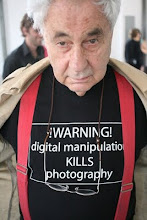GORO, HERB - The Block.
1970. Paper. New York: Random House / Vintage Books. 1970. (First edition). Large octavo. Stiff pictorial wraps. A gorgeous copy of this excellent profusely illustrated book. A wonderful book.
... Photobooks are commonly discussed, especially since the books about photobooks industry started to take off. There are many reasons why those kinds of books are doing the community a huge favour. After all, not only do they discuss the medium photobook in ways that it truly deserves, they also expose a lot of unknown books to a larger audience. Except, of course, that often enough you then see those books listed on Ebay, say, with, for example, “Parr/Badger” included in the subject line... Read for more ...
The Block is testimony of a really dark area of New York city and speci fically the Bronx. Herb Goro is New York photographer and journalist that spent a year in a project in the South East Bronx around 1966. This book shows how terrible it was already to live in the bronx in the 60’s. Throughout the book Goro interviews local families, social worker, kids, and took more than 180 amazing black and white pictures to document this tragedy in the making
First Edition 1970 Good Condition All pages intact. Some shelf wear to cover and yellowing on the inside coverSATURDAY, AUGUST 23, 2008
THE BLOCK by Herb Goro
An amazing document of inner city life.
"An account, in pictures and text, of the greatest social disaster in American history: a close-up of the death of a New York City slum and the destruction of the people who live there.
The book is the result of a year spent by the photographer Herb Goro in a decayed slum in New York's East Bronx. More than a hundred fifty thousand inhabitants of the area live and die in the rotted, sometimes abandonend tenements. The text consist of tape-recorded interviews with the people whom we see in the pictures - the tenants, the police, the men and women dying, and the parents of the children being born, Theirs is the hopeless struggle to survive in the city which has no need for these people and which barely manages any longer to even keep them alive.
THE BLOCK shows us how the people in this neighborhood live, but it concentrates on the lives of three adolescents, as they come of age, struggle briefly to survive, and fail. In New York there are countless people, many of them hardly more than children, who live and die like those on THE BLOCK. This book confronts us with a profound social pathology and with the personal misery that accompanies it."
POSTED BY - AT 2:26 PM























Geen opmerkingen:
Een reactie posten